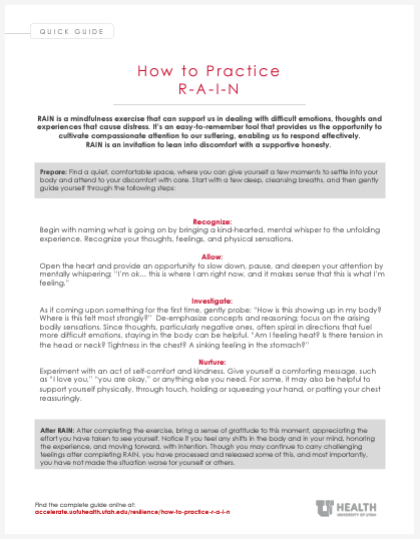is a mindfulness exercise that can support us in dealing with difficult emotions, thoughts and experiences that cause distress. This can be particularly helpful for those in the healing professions, where we often come face-to-face with illness and grief. Whether we are navigating a patient death, a negative or unexpected outcome, a medical mistake, or a challenging interpersonal conflict, the acronym RAIN is an easy-to-remember tool that provides us the opportunity to cultivate compassionate attention to our suffering, enabling us to respond effectively. RAIN is an invitation to lean into discomfort with a supportive honesty.
The Four Steps:
-
Recognize what is going on
-
Allow the experience to be there, just as it is
-
Investigate with interest and care
-
Nurture with self-compassion.
Mindfulness in Medicine Toolkit

Click here for a list of resources you and your team can use to practice mindfulness and increase your well-being.
What is happening in RAIN?
R – Recognize: When you acknowledge being in the throes of a difficult emotion, thought, or behavioral response, you provide yourself with an opening to see what is playing out in the body. Knowing what we are dealing with brings some relief to the mind.
A – Allow: Instead of turning away, shutting down, or pushing back, allow the recognized thoughts, emotions, or sensations to simply be. This creates a holding space in which the experience can be acknowledged and supported.
I – Investigate: Investigating through a non-judgmental curiosity opens you to the truth of what is unfolding, bringing clarity and honest appraisal to the situation.
N – Nurture: Nurturing yourself as you would a dear friend or family member in a similar situation brings self-compassion to your own suffering. You turn this most human of capacities—compassion for the suffering of others—towards your own hurt, which is a powerful act of self-healing.
How to practice RAIN
Guided Meditation
Practice the R-A-I-N Guided Meditation with Tara Brach.
Case study
You are working on the inpatient unit, caring for a gentleman who is angry about how long it is taking for test results to return and for the medical team to decide on a treatment plan. During morning rounds, in front of the entire team, you become the target of his wrath, a litany of aggressive and accusatory complaints, laid squarely on your shoulders. As you leave the room and try to move to your list of tasks, you find it difficult to focus, your heart thumping and frustration rising. You provide reassurance to your team and invite them to take a quick break. As they disperse, you step away to find some equilibrium—it’s time to practice RAIN…
Find a quiet, comfortable space, where you can give yourself a few moments to settle into your body and attend to your discomfort with care. Start with a few deep, cleansing breaths, and then gently guide yourself through the following steps:
Recognize: Begin with naming what is going on by bringing a kind-hearted, mental whisper to the unfolding experience, noting that which is most felt: “I am feeling angry at how this patient has spoken to me… I am feeling upset and off balance at how their words have landed.”
Allow: Open the heart and provide an opportunity to slow down, pause, and deepen your attention by mentally whispering: “I’m ok… this is where I am right now, and it makes sense that this is what I’m feeling.”
Investigate: As if coming upon something for the first time, gently probe: “How is this showing up in my body? Where is this felt most strongly?” De-emphasize concepts and reasoning; focus on the arising bodily sensations. Since thoughts, particularly negative ones, often spiral in directions that fuel more difficult emotions, staying in the body can be helpful. “Am I feeling heat? Is there tension in the head or neck? Tightness in the chest? A sinking feeling in the stomach?”
Nurture: Experiment with an act of self-comfort and kindness: “I’m going to be ok. I know what needs to be accomplished now, and I know how to do it well. I care about my patients, and I want what’s best for them.” For some, it may also be helpful to support yourself physically, through touch, holding or squeezing your hand, or patting your chest reassuringly.
After RAIN: After completing the exercise, bring a sense of gratitude to this moment, appreciating the effort you have taken to see yourself. Notice if you feel any shifts in the body and in your mind, honoring the experience, and moving forward, with intention. Though you may continue to carry challenging feelings after completing RAIN, you have processed and released some of this, and most importantly, you have not made the situation worse for yourself or others.
Once you become comfortable leading yourself through RAIN, consider facilitating this exercise with your team, in situations when you are collectively struggling with a shared challenge or trauma. This can be an incredibly healing process, and an invitation to speak openly and deeply amongst each other, building trust and resilience.
Resources:
This program is supported by the Health Resources and Services Administration (HRSA) of the U.S. Department of Health and Human Services (HHS). The contents are those of the author(s) and do not necessarily represent the official views of, nor an endorsement, by HRSA, HHS, or the U.S. Government. For more information, please visit HRSA.gov.
David Sandweiss
We can be so hard on ourselves. Contributors from the Resiliency Center share how self-compassion, the practice of being kind and fair to yourself during times of stress, can improve your well-being and resilience.
In a new column, the Practical Psychologist is here to answer your mental health questions. This week: a 30-second exercise you can do right now to build more self-compassion.
Well-being expert and physician David Sandweiss explores the art of mindful breathing. By incorporating just three conscious breaths into our day, we can transform the way we experience the world, offering a path to clarity, calm, and a deeper connection with the present moment.



